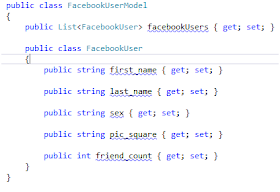After
we managed to log into facebook in my
previous post now it's time to get some data from facebook.
Facebook
allows us to query its data using 3 ways:
1.
Legacy REST API – allows you to
send requests and receive data via HTTP requests. Facebook are now in the process
of deprecating this feature.
2.
Graph API
3.
FQL – Facebook Query Language
All
facebook data is stored in huge tables (e.g. album, user, photo...), both Graph
API and FQL allow you to query that data. Graph API makes you send http
requests with the suitable parameters to get what you want as oppose to FQL
that allows you to write some sort of SQL kind of language to query the
facebook data.
Graph API example
Photo Albums: https://graph.facebook.com/me/albums?access_token=...
Try
them! You'll receive a JSON response (which
by the way you can switch to XML if you change the header of your request) with
all your friends and all your albums details.
FQL
In
my opinion it is a better way to query data from facebook because it reminds me
SQL that is simple and obvious. It allows me to filter my queries adding a
"where clause" that is used on indexed fields to increase performance
and it "looks" better (readable and clear) when using it from .net
class.
Let's see how
we can retrieve personal details from facebook to our website
The first thing you
need to do is go to http://developers.facebook.com/docs/reference/fql/
and scroll to the bottom where you'll see all the tables that can be queried. The
tables have pretty obvious names (I admit that I still haven't understood why particular
tables exist but I'm working on it) so as their columns. You can see the
columns and their description in every table (e.g. user table - http://developers.facebook.com/docs/reference/fql/user/
).
Similar
to SQL, FQL allows you to retrieve only the data that you want using the
SELECT statement. Opposed to SQL, FQL
requires you to use the WHERE clause not only in every query you run but you can query only fields
that are indexed (makes sense…you don't want to wait for a query that gets all the facebook users).
We
want to receive some basic details about the user that is logged in our
website. Mmm let's say we want his/her first name, last name, gender, profile
picture and friend count. That means we need the following fields (according to
the user table): first_name, last_name, sex,
pic_square and friend_count.
FQL
is built like a basic SQL query: SELECT field1, field2 FROM tableName
WHERE…
Me()
is a special facebook function that retrieves the logged in user id.
Now let's run
it from our website!
First
we create a new controller "UserDetailsController"
In order
to present the user details in the View we'll need a model:
"FacebookUserModel". The query retrieves JSON result so in order to
desirialize the JSON to an object we'll have to create an object with the exact
identical fields as the JSON response. One more thing: even though the query
will retrieve just a single user the response is built like the query is
supposed to retrieve an array of users so that our model will hold a list of
"FacebookUser" which will hold our 4 properties (no .net standards
=\)
Alright
now we have our model, let's add some logic to the controller. First we
need to connect to the facebook servers using the access token we received when
we logged in, then we need to send our FQL and receive the JSON response. To receive
a response from facebook we'll use the "Get" method that takes 2
arguments: path and object. Path tells facebook that is the second argument
type – in our case it's "fql". The second argument will hold the query itself.
Facebook
return JSON result that the best way to "hold it" is using dynamic
object. If you'll open your debugger you will see that response starts with the
word "data" and the whole response is surrounded with "[ ]"
brackets" because the response is an array.
After
we hold our JSON response all we have to do is desirialize it to an actual
object (To use the JsonConvert nugget "json" and add it to your
project – it's helpful). Remember! We don't deserialze the response to the
"FacebookUserModel" but to a list of "FacebookUser".
The
last thing we have to do is send the "FacebookUser" object to our
view. Oh right, we need to create a view…Right click inside our method and
choose "AddView". In the settings window choose "Create a
strongly-typed view" and choose the "FacebookUser" model class.
Doing
so we enable our view to access the model properties that the controller sent
it.
Simple html table with all the user's fields:
F5
the solution and login. Now add to your address the controller name.
Cool right?







Right ) Thank you for your example ;)
ReplyDeletebahis siteleri
ReplyDeletehttps://bahissiteleri.io
youwin
bets10
1xbet
S178